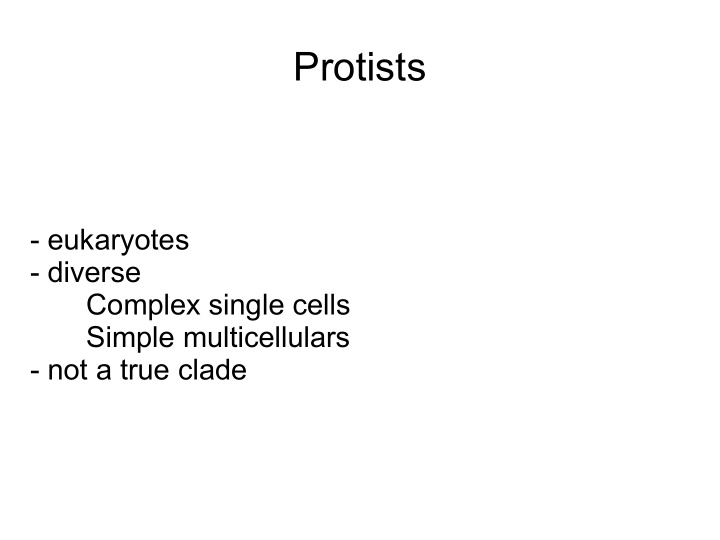



Protists - eukaryotes - diverse Complex single cells Simple multicellulars - not a true clade
3 types (by nutrition) ● Like animals: Protozoa ● Like plants: Algae ● Like fungi: slime molds, water molds, downy mildews
Protozoa – by movement ● Flagellates ● Amoeboids (with pseudopods) ● Ciliates ● Apicomplexans ● http://www.youtube.com/watch?v=QGAm6hMysTA
Protozoa – Flagellates ● Mostly free-living ● Some parasites cause human diseases (Giardia, Trypanosoma) ● Symbiont (Trichonympha) lives in termites, digests wood
Protozoa – Amoebas https://www.google.com/search?q=amoeba%20eng ● ● http://www.youtube.com/watch? v=7pR7TNzJ_pA c
Protozoa – Ciliates ● Paramecium ● http://www.youtube.com/watch?v=fh_yjLppNAg ● Rotifers
Protozoa – Ciliates - Rotifers ● “wheel-carriers” ● Their own phylum' about 2200 known species ● Multi-cellular (about 1000 cells) ● Eat detritus ● Some species are females-only
Protozoa – Apicomplexans ● Unmoving ● Parasites ● Complicated life cycles using 2 or more hosts ● Malaria: Plasmodium vivax
Fungus-like protists ● Slime molds: ● Plasmodial ● cellular ● Water molds ● Downy mildews
Plasmodial slime molds ● Decomposers; moist forest environments ● Plasmodium is a super-cell: many nuclei, no cell walls or membranes ● Form spores when food, water run out
Cellular slime molds ● Decomposers; moist forest environments ● Complex life cycle: individual – colony – spore ● Coordinated behavior ● http://www.youtube.com/watch? v=CIEggUBoivY ● http://www.youtube.com/watch?v=bkVhLJLG7ug ● http://www.youtube.com/watch? v=leKI3Cv9YYw
Water molds ● Most decompose dead plants in freshwater ● Some parasites of fish
Downy mildew ● Grow on plants (grapes, vine vegetables) ● Potatoes: Phytophthora infestans ● Irish potato famine: 1 million deaths ● 1.5 million emigrations ● Thousands lost land ● Political revolt: Irish independence ● Ireland is still low population ● Significant impact on American population
Algae ● Microscopic: Euglenoids, Dinoflagellates, diatoms ● http://www.youtube.com/watch?v=ZHZZKwrYm4g ● Photos are dinoflagellates
Algae ● Dinoflagellates: cellulose wall (like plants) ● Red tides ● Diatoms – glassy shells which fossilize ● “Diatomaceous earth” used for filtering, polishing, as a pesticide
Algae: Seaweeds ● Not a clade ● Entirely aquatic ● Marine and freshwater ● Have structures similar to plants but much less complex ● Many edible, used in ice cream, milkshakes... (carrageenan) ● Classified by color: Brown, red, green
Algae: Seaweeds ● Brown – not all are really brown ● most notable is kelp ● Red – include coralline algae ● Can grow deepest in ocean ● Sea hares eat and can squirt red ● ● http://www.marinelifephotography.com/marine/seawee ds/seaweeds.htm
Algae: Seaweeds ● Green – closest to land plants ● Single or multi-cells ● Complex life cycles ● We saw several kinds in pond water
Recommend
More recommend